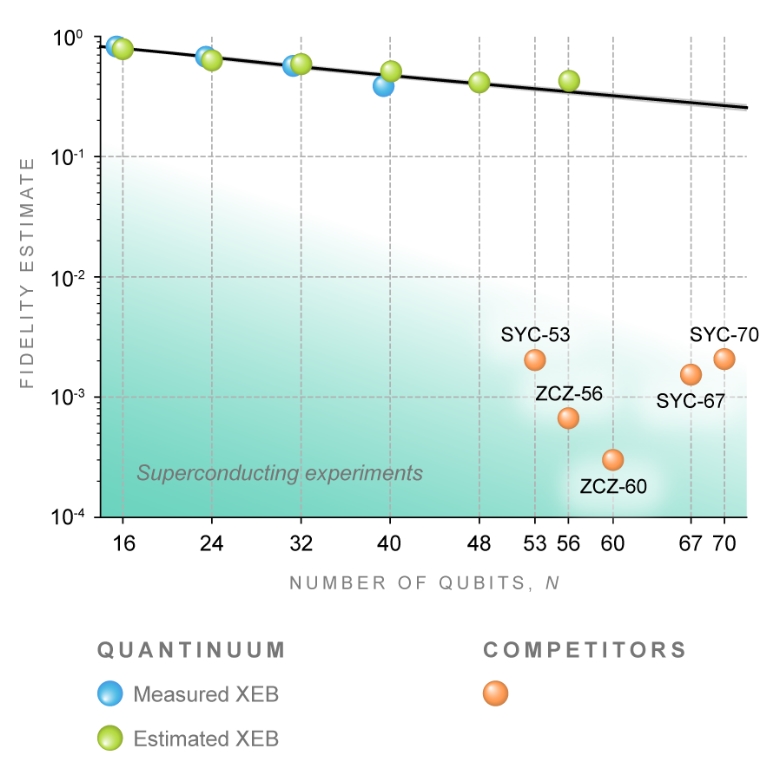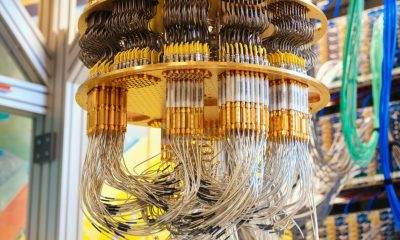Computing
Does Quantum Computing Have A First Real-World Use Case?
Securities.io maintains rigorous editorial standards and may receive compensation from reviewed links. We are not a registered investment adviser and this is not investment advice. Please view our affiliate disclosure.

Quantum, AI & Photonics: A New Computing Revolution
Computing and information technologies are undergoing several technological revolutions at once: the rise of AI, the emergence of quantum computing, and the turn to photonics to overcome the limitations of classic silicon computing.
So far, each of these new sectors has mostly worked in isolated silos: AI training and computing is performed on classical silicon chips, quantum computing is looking to improve its technology until it can find a practical use, and photonics technology is still experimenting on designs and applications.
Maybe unsurprisingly, it could be that it is by merging these fields together that new possibilities emerge. It seems that quantum computing might just have found a practical use case, and would not even need further improvement before being useful.
Researchers at the Vienna Center for Quantum Science and Technology (VCQ) (Austria), the Politecnico di Milano (Italy), Consiglio Nazionale delle Ricerche (IFN-CNR) (Italy), and the company Quantinuum (UK) have found that existing quantum computers could outperform classical computer in AI training, using a photonic processor.
They published their results in Nature Photonics1, under the title “Experimental quantum-enhanced kernel-based machine learning on a photonic processor”.
Why AI Training and Quantum Computing Face Limits
AI Training’s Soaring Costs and Energy Demands
Recently, AI technology has made tremendous progress. This was however achieved only through the use of mind-boggling amounts of computing power, consuming tens of billions of dollars in chips and electricity.
Certainly, some progress can be made in efficiency, as demonstrated by DeepSeek AI trained with ultra-low cost in both computing and money, beating its Western competitors by an order of magnitude. But still, at the end of the day, software improvement will only go so far in making AI training less compute and power-intensive.
Quantum Computing’s Scalability and Noise Challenges
Meanwhile, Quantum computing is a promising technology, but until now suffering from a fatal flaw. The extremely fragile state of matter needing to be maintained for quantum computing to work means it is both expensive and not very scalable.
It also means that the results obtained are “noisy”, with regular errors, delays, and unreliable results.
Here too, innovations could mean that either a network of smaller quantum computers or a new hardware design architecture, using a new state of matter called topoconductors, allowing for scalability, could solve the problem.
Until it is confirmed, this has nevertheless put into question the relevance of quantum computing, still a technology in search of a practical use case that makes sense economically.
Quantum-Enhanced Kernel Methods for AI
How Quantum Kernels Add Dimensional Power to Machine Learning
Kernel methods are widely used tools in machine learning, and use a mathematical method of adding dimensions to a dataset for better identification of hidden patterns.

Source: MDPI
This, of course, involves quite complex mathematics, which will be mostly understandable only for a limited set of specialists already working in this field. You can see a visual representation of how it works in this video:
And such complex calculations could be a perfect fit for the unique capacities of quantum computers.
Photonic Processors Meet Quantum Kernels for AI
An integrated photonic processor, created via femtosecond laser writing on a borosilicate glass substrate, was used for this experiment to encode the data into a state that can be treated by a quantum computer.

Source: Nature Photonics
This way, kernels displaying quantum interference were used for the calculation and compared to classical methods.

Source: Nature Photonics
Experimental Results: Quantum vs. Classical Kernels
The scientists tested four different dataset sizes, ranging from 40 to 100 data points, where the quantum kernel (in blue) was compared to the classical kernel (in orange).

Source: Nature Photonics
In both experiments, the quantum kernel performed better than the classical computing one.
“We found that for specific tasks our algorithm commits fewer errors than its classical counterpart.”
Philip Walther – Professor at the University of Vienna.
Next Steps Toward Real-World Quantum AI Training
Moving From Demo to Production: Quantum AI Training
This experiment demonstrated that quantum computers, which exist today, can outperform classical computers in tasks commonly used in neural network training.
This is a big deal because until now, it was assumed that only a more reliable quantum computer could ever be used for this kind of application. Now that this has been experimentally proven to not be true, the next step will be to do even a limited run of performing real-life AI training with that technology.
For this, new algorithms inspired by quantum architectures could be designed, reaching better performances.
“This implies that existing quantum computers can show good performances without necessarily going beyond the state-of-the-art Technology”
Zhenghao Yin – PhD Student at the University of Vienna.
How Quantum-Photonics Cuts AI Energy Use
Photonics platforms can perform the same or a superior computing output with a much lower energy consumption. As energy is increasingly becoming the bottleneck of the AI industry, more than computing capacity or innovations, this could make the use of quantum-photonic computer discovery especially important.
“This could prove crucial in the future, given that machine learning algorithms are becoming infeasible, due to the too high energy demands”.
Iris Agresti – PhD Student at the University of Vienna.
Trapped-Ion vs. Superconducting Quantum Tech: What Comes Next?
It could have important consequences for the direction of the quantum computing industry.
So far, the field has been split between trapped-ion technology, with high reliability, but low quantum computing capacity (qubit) per device, versus more complex designs relying on superconductivity, so far very noisy, but which are also more likely to ultimately be scalable to a large qubit volume.
The research was produced in a very close partnership with Quantinuum, with 4 out of 12 of the scientists in the article working at this company. As a trapped-ion technology specialist, it makes sense for Quantinuum to look for a situation where the low qubit count of its computers can already perform a relevant business case.
If this turns out to be true, it could make the company a key provider of computing capacity to the AI industry, maybe mimicking at least a fraction of Nvidia's (NVDA -2.54%) achievements.
Investing in Quantum Computing
Honeywell / Quantinuum
Honeywell International Inc. (HON +0.58%)
Quantinuum is the result of the merger of Honeywell Quantum Solutions and Cambridge Quantum.
Honeywell remains the company's majority shareholder (likely 52% ownership) after a fundraising round valuing it at $5B. Founder Ilyas Khan is reported to own approximately 20% of the company. Other shareholders include JSR Corporation, Mitsui, Amgen, IBM, and JP Morgan.
A potential IPO of Quantinuum in the future, potentially as a part of a larger corporate restructuring, is estimated to be worth as much as $20B and might occur between 2026 to 2027.
Quantum computing is not the central part of Honeywell's business, more centered around products in aerospace, automation, and specialty chemicals & materials.
Each of these domains might, however, benefit from quantum computing, especially computational chemistry and quantum cybersecurity, potentially giving Honeywell an advantage against its competitors.
The company's main model for now is the H2, a trapped-ion 56 qubits chip, with 99.895% two-qubit gate fidelity.
The company has pursued high-quality computing with very little error more than adding as many as possible qubits, creating a so-called “fault-tolerant quantum computing”.
This approach is labeled by the company “Better qubits, better results”, with a similar amount of qubits achieving 100-1,000 fold more reliable results.

Source: Quantinuum
This notably could make a difference in urgently needed quantum-resistant cryptography, with defense company Thales (HO.PA -0.96%) already collaborating with Quantinuum as well as the international banks HSBC and JP Morgan.
Quantinuum also offers its proprietary quantum computational chemistry InQuanto, usable for pharmaceuticals, material sciences, chemicals, energy, and aerospace applications.
Like many other quantum computing companies, Quantinuum offers Helios, a “hardware-as-a-service”, allowing users to benefit from quantum computing without having to deal with the complexity of operating the system themselves.
Quantinuum signed in November 2024 a partnership with German Infineon, Europe’s largest semiconductor manufacturer. Infineon will bring its integrated photonics and control electronics technology to help create the next generation of trapped-ion quantum computers.
As integrated photonics are moving closer to practical use cases, it becomes now clear how important this partnership might be for the future of Quantinuum. At this point, it seems that the next step for the company will be to release the world's first AI-focused photonics-quantum chip.
In the coming months, Quantinuum will share results from ongoing collaborations, showcasing the groundbreaking potential of quantum-driven advancements in Generative AI.
The innovative Gen QAI capability will enhance and accelerate the use of Metallic Organic Frameworks for drug delivery, paving the way for more efficient and personalized treatment options, with details to be unveiled at the launch of Helios.
Quantinuum Announces Generative Quantum AI Breakthrough with Massive Commercial Potential
The announcement in this publication is part of a string of news related to the quick progress of the AI-quantum computing connection made at Quantinuum.
More ongoing use cases could strongly boost the future value of the company, and therefore, Honeywell’s stack in it and the potential profit investors could make from it.
Latest Honeywell / Quantinuum (HON) Stock News and Developments
Honeywell Gears Up to Report Q2 Earnings: Is a Beat in Store?
Exploring Analyst Estimates for Honeywell International (HON) Q2 Earnings, Beyond Revenue and EPS
4 Diversified Operations Stocks to Consider on Promising Industry Trends
Honeywell International Inc. (HON) Reports Next Week: Wall Street Expects Earnings Growth
4 Dow Jones Stocks Near 52-Week Highs That Are Still Worth Buying in July
Honeywell International Inc. (HON) Registers a Bigger Fall Than the Market: Important Facts to Note
Study Referenced
1. Yin, Z., Agresti, I., de Felice, G. et al. Experimental quantum-enhanced kernel-based machine learning on a photonic processor. Nature Photonics. (2025). https://doi.org/10.1038/s41566-025-01682-5













